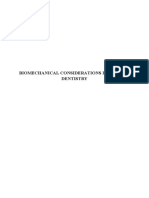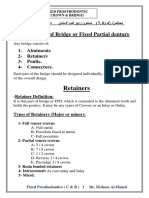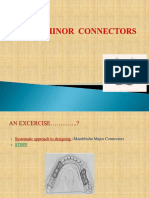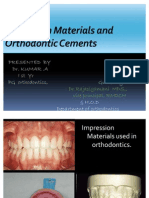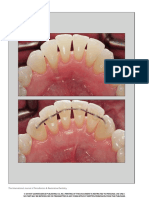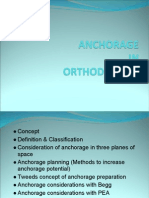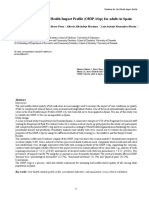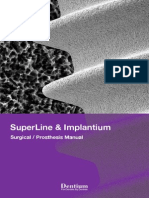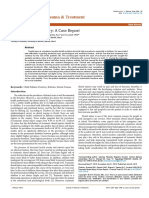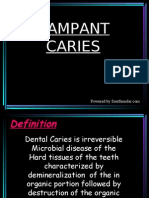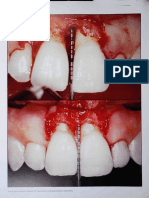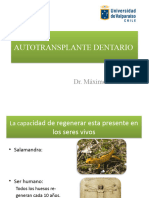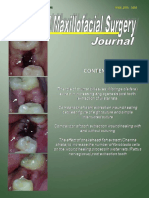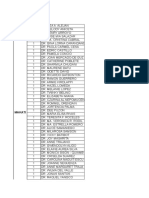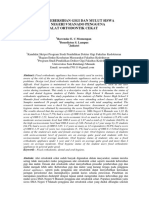Indirect Retainers
Indirect Retainers
Uploaded by
takkykumasangCopyright:
Available Formats
Indirect Retainers
Indirect Retainers
Uploaded by
takkykumasangCopyright
Available Formats
Share this document
Did you find this document useful?
Is this content inappropriate?
Copyright:
Available Formats
Indirect Retainers
Indirect Retainers
Uploaded by
takkykumasangCopyright:
Available Formats
INDIRECT RETAINERS
An indirect retainer is that portion of the RPD that prevent
rotation of the saddle away from the tissues by creating
resistance on the opposite side of the fulcrum line.
Indications
1- Class I & II RPD’S require anterior indirect retainers
as the saddle lying posteriorly.
The movement of the RPD towards or away from the
residual ridge occurs around an imaginary line passing
between the most posterior abutments.
2- Class IV (long anterior edentulous span) requires
posterior indirect retainers as the saddle lying
anteriorly).
N B: - When the denture tends to rotate towards the tissues,
the fulcrum line is between the two principal occlusal rests,
while rotation away from the tissues occurs around an axis
between the retentive tips of the direct retainer. This
movement is controlled by the indirect retention.
Functions of the indirect retainers
1- Primary function is to prevent the rotation of the base away
from the tissues by creating a resistance on the opposite side
of the fulcrum line.
2- Auxiliary functions
a- Reduces the antero-posterior tilting leverage on the
principal abutments as the base lifts away from the
tissues.
b- Aids in stabilization against the horizontal movement
through the contact of its minor connector with the axial
tooth surfaces
c- May act as auxiliary supporting units to support a portion
of the major connector
e.g. A lingual bar may be supported against settling
into the tissues by the indirect retainer acting as an
auxiliary rest
Factors affecting the effectiveness of indirect
retainers:-
1- Effectiveness of direct retainers
Unless the principal occlusal rest are held in their seats by the
retentive arms of the direct retainers, total displacement will
occur instead of rotation of the RPD & thus the indirect retainer
can resist rotational rather than displacement.
2- Distance from the fulcrum line
By increasing the distance between the fulcrum line & indirect
retainers~
N.B: Increases the effectiveness of indirect retainers:
A line perpendicular to the fulcrum line & ending in a tooth
that is capable of supporting a suitable rest preparation will
indicate the most effective location for indirect retention. The
longer this line, the more favorable will be the result, but
however, the distance depends on:-
a- Location of the fulcrum line.
b- Length of the distal extension base & number of
standing teeth.
c- How far beyond the fulcrum line the indirect retainer is
placed.
3- Rigidity of connectors that support the indirect retainers:-
If the arm is able to flex, forces would
be multiplied ( increase forces on the
abutment) instead of dissipated .
4- Effectiveness of the supporting tooth surface
Tooth inclines & weak teeth should
never be used for the support of indirect
retainers:-
Forms of Indirect Retainers:
1- Auxiliary occlusal rest on the mesial fossa of the first
premolar:-
It is frequent to find the most effective location of indirect
retainers in the vicinity of an incisor tooth, but however
that tooth may not be strong enough to support an
indirect retainers, or it may have steep inclines that
cannot favorably altered to support a rest without
damaging the tooth structure. In such cases we have two
choices:-
a- canine rests
b- mesio-occlusal surface of the first premolar, more
favorable than canine rests, because the surface is
horizontal not inclined.
In Class I RPD a bilateral occlusal rest is used but with
Class II RPD usually unilateral occlusal rest is enough
except when the occlusal rest is needed to support a
major connector.
2- Canine extension from occlusal rest
It is a finger like extension from a premolar rest placed
on the canine.
It is indicated when the first
premolar serve as a primary
abutment, so the occlusal rest on the
mesial fossa is not effective as
indirect retainers.
3- Continuous bar retainer & lingual plate
Technically, they are not retainers since they rest on an
unprepared lingually inclines of anterior teeth.
The indirect retention is actually derived from the
terminal rests at either end in form of auxiliary occlusal
rest or canine rests.
The continuous bar & the superior edge of the lingual
plate should never be placed above the middle third of the
tooth, so that orthodontic movement of the teeth during
rotation of the distal extension base is avoided.
4- Rugae Support
Rugae covering can act as indirect retainers for the maxillary
denture but with poor patient tolerance.
5- Direct-Indirect Retention
In the maxillary arch where only anterior teeth remain, full
palatal coverage is usually necessary, the added retention &
lesser bulk of the cast metal is usually adequate to prevent
lifting of the base away from the tissues & provide direct-
indirect retention.
6- Posterior palatal bar & posterior extension of palatal
strap.
Both lie posteriorly so can provide indirect retention for class
IV RPD.
N.B. In the upper arch, the teeth & hard palate may be used
to support the indirect retainer while in the lower jaw the teeth
only can be used for this purpose.
G D LUCK
Dr. M. El.SAMAHY's Lecture
You might also like
- Biomechanics in Implants PDDocument28 pagesBiomechanics in Implants PDNikita AggarwalNo ratings yet
- Rests Rest SeatsDocument42 pagesRests Rest SeatsSahana RangarajanNo ratings yet
- (Year 3) Removable Prosthodontics Practical - Indirect RetainersDocument6 pages(Year 3) Removable Prosthodontics Practical - Indirect Retainerstae hyungNo ratings yet
- Components of RPDDocument5 pagesComponents of RPDsareh_ghodsiNo ratings yet
- Rest and Rest SeatDocument27 pagesRest and Rest SeatKreeti MishraNo ratings yet
- Rests: Rest SeatsDocument43 pagesRests: Rest Seatsreem eltyebNo ratings yet
- Design Considerations in RPD For Control of StressDocument7 pagesDesign Considerations in RPD For Control of StressSahana RangarajanNo ratings yet
- Teeth SelectionDocument77 pagesTeeth SelectionAnurag AgarwalNo ratings yet
- Management of Alveolar Ridge ResorptionDocument29 pagesManagement of Alveolar Ridge Resorptionفواز نميرNo ratings yet
- Classification System For Complete EdentulismDocument33 pagesClassification System For Complete EdentulismSahana RangarajanNo ratings yet
- Different Techniques For Management of Pier Abutment: Reports of Three Cases With Review of LiteratureDocument4 pagesDifferent Techniques For Management of Pier Abutment: Reports of Three Cases With Review of Literatureahmad955mlsNo ratings yet
- Removable Prosthodontics II - Lec.10, Indirect Retainers - Noor Al-Deen M. Al-KhanatiDocument3 pagesRemovable Prosthodontics II - Lec.10, Indirect Retainers - Noor Al-Deen M. Al-KhanatiNoor Al-Deen Maher100% (1)
- Minor Connectors Rests and Rest Seats in Removable Dental ProsthesisDocument68 pagesMinor Connectors Rests and Rest Seats in Removable Dental ProsthesismujtabaNo ratings yet
- Relining and RebasingDocument28 pagesRelining and RebasingAan Mi'dad100% (2)
- Arrangement of TeethDocument65 pagesArrangement of TeethIbrahim Ramadan Eltorky100% (1)
- Retainers: Componet of Bridge or Fixed Partial DentureDocument12 pagesRetainers: Componet of Bridge or Fixed Partial DentureM.R PsychopathNo ratings yet
- ConnectorsDocument24 pagesConnectorsVikas Aggarwal100% (1)
- Rests & Rest SeatsDocument42 pagesRests & Rest SeatsAhmad Khalid HumidatNo ratings yet
- Minor ConnectorsDocument61 pagesMinor Connectorssarah100% (1)
- Biomechanics in Removable Partial DentureDocument25 pagesBiomechanics in Removable Partial DentureDũng PhạmNo ratings yet
- Sequelae by Complete Denture OriginalDocument58 pagesSequelae by Complete Denture Originalaayush100% (2)
- Special Tray Fabrication-130912012832-Phpapp01Document26 pagesSpecial Tray Fabrication-130912012832-Phpapp01OTNo ratings yet
- Rests and Rest Seats: 3Rd Grade LEC. 9Document11 pagesRests and Rest Seats: 3Rd Grade LEC. 9Akanksha MahajanNo ratings yet
- RPD ImpressionDocument49 pagesRPD ImpressionAmar Bimavarapu0% (1)
- Preparation of CastsDocument18 pagesPreparation of Castsfitsum100% (1)
- 5 Direct RetainersDocument56 pages5 Direct RetainersKandiwapa ShivuteNo ratings yet
- Rest and Rest SeatsDocument20 pagesRest and Rest SeatsCharmiNo ratings yet
- Direct RetainerDocument90 pagesDirect RetainerfarahNo ratings yet
- Prosthodontics Key Points by DANESHDocument21 pagesProsthodontics Key Points by DANESHNoor HaiderNo ratings yet
- Residual Ridge ResorptionDocument57 pagesResidual Ridge ResorptionPhoebe DavidNo ratings yet
- BiomechanicsDocument99 pagesBiomechanicsRamnarayan Meena100% (1)
- Lecture7 (3 Year) (Prosthetics Dentistry) :: Minor ConnectorsDocument7 pagesLecture7 (3 Year) (Prosthetics Dentistry) :: Minor ConnectorsruchikaNo ratings yet
- A Review On Stresses-Induced by Removable Partial DenturesDocument5 pagesA Review On Stresses-Induced by Removable Partial DenturesKrupali JainNo ratings yet
- 04 Splintstrismus 140501160338 Phpapp02Document56 pages04 Splintstrismus 140501160338 Phpapp02hazeemmegahedNo ratings yet
- Single Complete DenturesDocument20 pagesSingle Complete DenturesDeepthi RajeshNo ratings yet
- Wax Up and Cervical CarvingDocument31 pagesWax Up and Cervical CarvingArun ThathiNo ratings yet
- Section - 037 - Denture Occlusion - Non-BalancedDocument14 pagesSection - 037 - Denture Occlusion - Non-BalancedWafa AbdurahmanNo ratings yet
- Inter Occlusal Records in FPDDocument24 pagesInter Occlusal Records in FPDGaurav ChachanNo ratings yet
- List of Topics For Prosthodontics 2nd Year Ug LectureDocument2 pagesList of Topics For Prosthodontics 2nd Year Ug LectureMrunal DoiphodeNo ratings yet
- CD Class 270117Document233 pagesCD Class 270117Vishal SharmaNo ratings yet
- Impression Materials New EraDocument116 pagesImpression Materials New EraKumar A Mds100% (1)
- Vertical Jaw Relation: Harshandi Bodele Final Year BdsDocument55 pagesVertical Jaw Relation: Harshandi Bodele Final Year Bds11 Harshandi BodeleNo ratings yet
- Impressions in RPDDocument23 pagesImpressions in RPDfayiza kkolilNo ratings yet
- Prostho Rehabilitation - HypodontiaDocument24 pagesProstho Rehabilitation - HypodontiaAmniAzmiNo ratings yet
- Arrangement of Artificial Teeth: Dr. Enas Abdul-SattarDocument50 pagesArrangement of Artificial Teeth: Dr. Enas Abdul-SattarShashank AadarshNo ratings yet
- Try in FPDDocument40 pagesTry in FPDharshini100% (1)
- Journal Club PresentationDocument39 pagesJournal Club PresentationArchana PanwarNo ratings yet
- Cantor and Curtis ClassificationDocument4 pagesCantor and Curtis ClassificationMuhammad AwaisNo ratings yet
- Major Connectors and Minor Connectors: DR Prathibha Prasad Mds 1 Year KcdsDocument93 pagesMajor Connectors and Minor Connectors: DR Prathibha Prasad Mds 1 Year KcdsMNSNo ratings yet
- Good Maxillofacial ArticleDocument11 pagesGood Maxillofacial Articledrchabra dentalNo ratings yet
- Prosthodontics Horizontal Jaw Relation: Dr. Firas AbdulameerDocument6 pagesProsthodontics Horizontal Jaw Relation: Dr. Firas AbdulameerSahana RangarajanNo ratings yet
- Lec 4 Prosthodontics PDFDocument7 pagesLec 4 Prosthodontics PDFmustafa7calligrapherNo ratings yet
- Complete Dentures: Establishing and Maintaining Mandibular Equilibration With Complete DenturesDocument6 pagesComplete Dentures: Establishing and Maintaining Mandibular Equilibration With Complete DenturesAmar Bhochhibhoya100% (1)
- Role of Tongue N Floor of Mouth in CD TRTDocument18 pagesRole of Tongue N Floor of Mouth in CD TRTashoorocks100% (1)
- Alloys For FPDDocument101 pagesAlloys For FPDsapna100% (1)
- Bennet Movement-5 PDFDocument23 pagesBennet Movement-5 PDFVrinda GuptaNo ratings yet
- Impressions For FPDDocument53 pagesImpressions For FPDpragatiNo ratings yet
- The International Journal of Periodontics & Restorative DentistryDocument7 pagesThe International Journal of Periodontics & Restorative DentistrytaniaNo ratings yet
- Digital Smile Design For Computer Assisted Esthetic RehabilitationDocument10 pagesDigital Smile Design For Computer Assisted Esthetic RehabilitationRoberto PucNo ratings yet
- GrandiniDocument12 pagesGrandiniCalfa CornelNo ratings yet
- Anchorage in OrthodonticsDocument123 pagesAnchorage in OrthodonticsNadiah Sulaiman100% (2)
- Validation The Oral Health Impact Profile (OHIP-14sp) For Adults in SpainDocument7 pagesValidation The Oral Health Impact Profile (OHIP-14sp) For Adults in SpainMuhammad IqbalNo ratings yet
- Comparison of Different Fluoride Solutions Application On Dentin Caries Lesions in Primary TeethDocument5 pagesComparison of Different Fluoride Solutions Application On Dentin Caries Lesions in Primary TeethScivision PublishersNo ratings yet
- SuperLine and Implantium (Manual)Document50 pagesSuperLine and Implantium (Manual)Ovidiu NeculauNo ratings yet
- Limiting Private Equity Dentistry: A Report by Michael Davis, DDSDocument107 pagesLimiting Private Equity Dentistry: A Report by Michael Davis, DDSDentist The MenaceNo ratings yet
- Oral Surgery Midterm NotesDocument3 pagesOral Surgery Midterm Notesabsjob1No ratings yet
- Book Reviews: Lingual OrthodonticsDocument1 pageBook Reviews: Lingual OrthodonticsMedical TubeNo ratings yet
- Journal of Trauma & Treatment: Traumatic Dental Injury: A Case ReportDocument4 pagesJournal of Trauma & Treatment: Traumatic Dental Injury: A Case ReportriaNo ratings yet
- Lesson 5 Core Elements Evidenced Based Gerontological Nursing PracticeDocument38 pagesLesson 5 Core Elements Evidenced Based Gerontological Nursing PracticeSam Garcia100% (1)
- Pre Prosthetic SurgeryDocument29 pagesPre Prosthetic SurgeryDentist HereNo ratings yet
- The Orthodontics Effective RoleDocument31 pagesThe Orthodontics Effective RoleHamza BelhajNo ratings yet
- Rampant Caries PedoDocument31 pagesRampant Caries PedonemidoonamNo ratings yet
- Custom Post and Core Case ReportDocument10 pagesCustom Post and Core Case ReportDrAditya BansalNo ratings yet
- 99 IJPRD EMD TechDocument10 pages99 IJPRD EMD Techinamboy7No ratings yet
- What Should You Look For in A Curing Light?: ClinicalDocument4 pagesWhat Should You Look For in A Curing Light?: Clinicalsmiledesigner_13No ratings yet
- The Community Periodontal Index of Treatment NeedDocument7 pagesThe Community Periodontal Index of Treatment NeedLaween AbdulkhaliqNo ratings yet
- Crown and Bridge: Lecture (3) Third ClassDocument10 pagesCrown and Bridge: Lecture (3) Third Classسامر الرفاعيNo ratings yet
- Autotrasplante DentarioDocument24 pagesAutotrasplante Dentariofranco.getouNo ratings yet
- Oral and Maxillofacial Surgery Journal (E-Journal) Vol.5 No.1 Jan-Juni 2016Document5 pagesOral and Maxillofacial Surgery Journal (E-Journal) Vol.5 No.1 Jan-Juni 2016Niketa KhairinaNo ratings yet
- Etiology of MalocclusionDocument48 pagesEtiology of MalocclusionGilani Syed Sohaib100% (1)
- DentalDocument8 pagesDentalgoerginamarquezNo ratings yet
- All-On-4 Treatment of Highly AtrophicDocument7 pagesAll-On-4 Treatment of Highly AtrophicdeliveryworkNo ratings yet
- MFDS Candidate GuidanceDocument7 pagesMFDS Candidate Guidancew SMN100% (2)
- 0verview of Dental ImplantologyDocument70 pages0verview of Dental ImplantologysabbyNo ratings yet
- Status Kebersihan Gigi Dan Mulut Siswa Sma Negeri 9 Manado Pengguna Alat Ortodontik CekatDocument8 pagesStatus Kebersihan Gigi Dan Mulut Siswa Sma Negeri 9 Manado Pengguna Alat Ortodontik CekatIda Ayu TrisnaNo ratings yet
- Redo of A Root Canal orDocument42 pagesRedo of A Root Canal orPankaj TomarNo ratings yet
